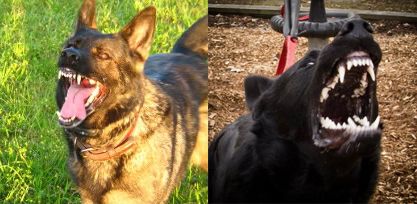I think sweeping statements can make people worry needlessly about their dogs. Even though I've never seen avoidance in my dog that hackled, because I read negative things about hackles, it still made me worry. My dog isn't scared of squirrels, possums, or raccoons. She eliminates them, but she'll hackle before she does it. With her, hackling means serious, very forward and bold behavior is about to follow... I'm convinced it's an adrenaline rush in her case. I have a nervy pointy eared mix that I don't think I've ever seen hackle...
Here's some alternative explanations to hackling that differ from the nervy diagnosis, just to balance this thread:
http://www.leerburg.com/ubbthreads/showflat.php/Cat/0/Number/103106/page/6/fpart/1/vc/1
http://www.leerburg.com/ubbthreads/showf...rue#Post4140579
Fight behaviors are not fully developed until the dog is about two years of age, and
sometimes later, although tendencies toward these behaviors will be seen at an earlier
age. Behaviors associated with fight are:
hackles up from the shoulder forward
standing tall and staring at other dogs
standing ground or going to unfamiliar objects
guarding food, toys or territory against other people and dogs
dislike of being petted or groomed
lying in front of doorways or cupboards and refusing to move
growling at people or dogs
putting the head over the shoulder of another dog
biting people or other dogs
http://www.volhard.com/general/artbywv.htm
Defense driven dogs are those who are suspicious of anything abnormal around them.
They are often quick to stiffen, raise their tails, bark, stare, hackle up, show teeth,
and growl to make threats go away. These dogs trigger on people who move toward them,
stare at them, stand or reach over them, speak in a gruff voice to them, etc. Prior to
maturity, these dogs will try to bluff to get people to stay away. After maturity, they
will be more willing to approach and carry out a bite to make people go away. These are
not fear biters that engage in this behavior only when there is no other option. They get
a charge out of challenging and overcoming others.
http://www.dogpro.org/index.php?pageID=63
Fight vs. Play Fight -hackles may be raised-muscles will be flexed-will stand on
its toes-tail will be stiff and held slightly raised and be waving in short stiff
strokes-intense stare-forward stance
http://64.233.161.104/search?q=cache:QOT...clnk&cd=136
Major Dominance Displays - Brave
Placing chin on the other dogs shoulders
Growling or snarling if the other dog whines or attempts to move
Placing the front paw on the other dogs back.
Circling and sniffing the other dog.
Holding ears erect.
Looking directly at the other dog.
Deliberately marking the area with urine.
Hackles raised.
http://www.richmonddogtraining.com/behavioral_patterns.htm
The initial stages of instruction were similar to those employed in training sentry dogs,
but the scout dog was taught not to bark or growl, and more emphasis was placed upon
accustoming the animal to heavy gunfire. Since the dog was expected to discover an alien
presence partly by his ability to detect wind-blown scent and partly by his extraordinarily
keen hearing, instruction was aimed at stimulating him to employ these natural endowments.
The dog was trained to detect human scent as a bird dog is trained to detect hidden birds.
When he "winded the enemy" he signified his discovery by "freezing" stiffening his body,
raising his hackles, pricking his ears and holding his tail rigid.
http://www.uswardogs.org/id24.html
 Previous Topic
Previous Topic Index
Index Next Topic
Next Topic












 Top
Top




